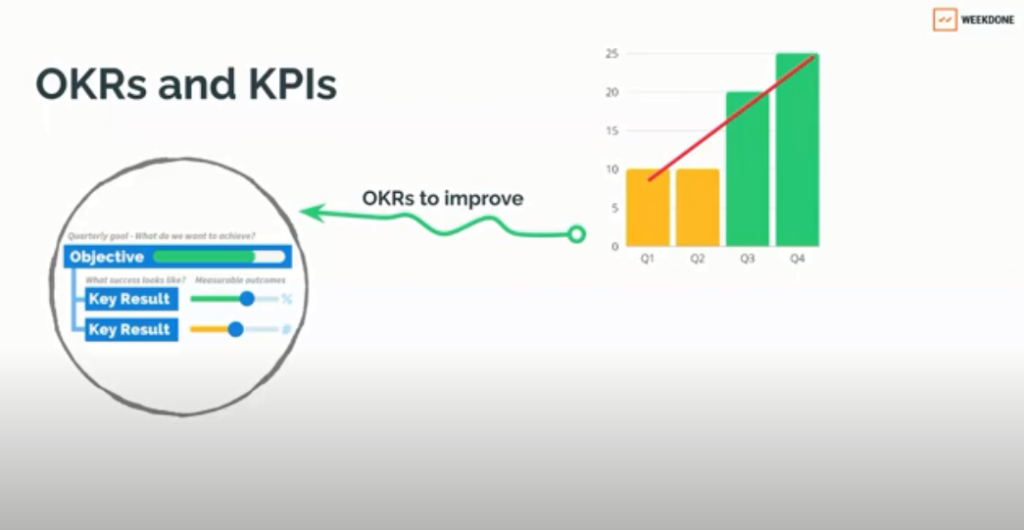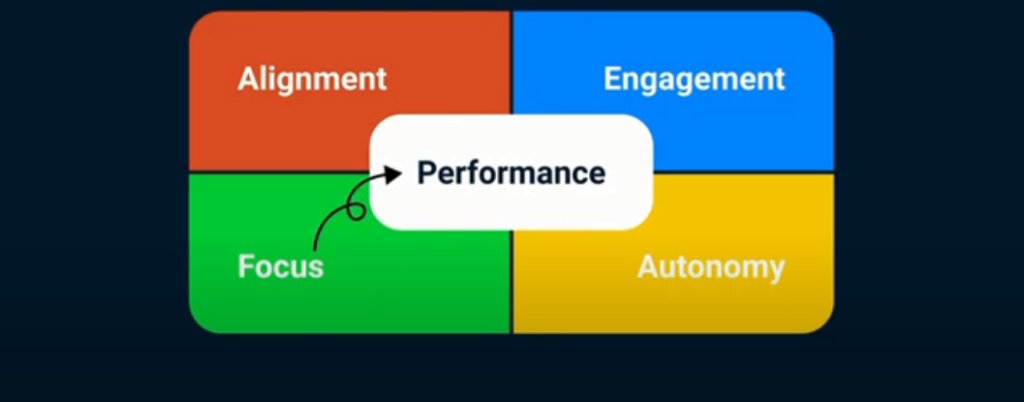In the dynamic business environment of today, project leads constantly scout for efficacious tactics for triumph. One increasingly favored approach is the OKR (Objectives and Key Results) model.
The OKR model serves as a goal-oriented mechanism aiding organizations in aligning their endeavors, monitoring developments, and accomplishing formidable objectives.
Grasping OKR: The Fundamentals
Originating at Intel during the late 1970s and later popularised by Google, the OKR system consists of two elements: Objectives and Key Results.
Objectives demarcate the bold targets an organization or team strives to attain. Key Results are measurable metrics monitoring the journey towards these objectives. While typically set quarterly, OKRs can be modified more frequently according to the project requirements.
The OKR Approach
Goals ought to be motivating, demanding, and in harmony with the organizational vision. They aim to encourage and equip teams to deliver outstanding outcomes. Clear, succinct, and striking objectives enhance focus and ensure a common understanding of primary targets.
Key Result Definition: Key Results are tangible outcomes indicating advancement toward objectives. They are particular, time-bound, and quantifiable. Each objective can associate with multiple key outcomes, offering a comprehensive image of progress. Key results should be ambitious, yet attainable, inspiring teams to aim for perfection;
Continual assessment and modification: OKRs are not fixed; they necessitate continual evaluation and adjustment.
Periodic assessments, typically weekly or bi-weekly, enable teams to track advancement, pinpoint issues, and implement necessary alterations to maintain the course. The iterative nature of OKR presents a flexible and responsive strategy for project governance.
OKR Functioning?
OKR is a goal-oriented system assisting organizations and teams in defining and tracking their objectives and deliverables. They offer clarity, uniformity, and focus, permitting teams to collectively work towards shared objectives.
The functioning here is as follows:
- Goal Definition: Goals are qualitative and aspirational statements demarcating what an organization or team aspires to accomplish. Goals should be bold, inspiring, and in sync with the organization’s overarching mission and vision. They answer the question, “What is our objective?”;
- Defining Measurable Outcomes: These outcomes serve as tangible markers for progress towards set objectives. They are explicit, time-framed, and quantifiable. These outcomes answer the query, “How can we confirm if we have attained our objectives?” Each goal can be linked to multiple key outcomes, offering a thorough understanding of advancement;
- Establishing OKRs: Generally, OKRs are initiated at an organizational level and then disseminated to teams and individual contributors. This process ensures uniformity and consolidates the efforts of various segments to meet common objectives. Goals and crucial deliverables at every level should be interconnected and contribute towards the attainment of higher-level objectives;
- Routine Evaluations and Progress Monitoring: Regular check-ups and tracking are mandatory for OKRs. Teams usually conduct weekly, bi-weekly, or monthly assessments to update their OKRs. These reviews facilitate progress evaluation, problem identification, and necessary adjustments, promoting transparency and team communication;
- Ambitious and Forward-Looking Objectives: OKRs advocate the establishment of ambitious and far-reaching goals that extend beyond what is comfortably attainable. The intention is to galvanize and push teams to exceed their limits and aim for extraordinary results. OKRs are designed not to be easy; they are intended to stimulate and inspire teams to excel;
- Ongoing Learning and Enhancement: OKRs encourage a culture of perpetual learning and enhancement. If a measurable outcome is not met, it serves as a chance for reflection and learning rather than failure. Teams can scrutinize the reasons for such an outcome, pinpoint improvement areas, and adjust their strategies in subsequent OKR cycles;
- Transparency and Responsibility: OKRs enhance transparency by making goals and measurable outcomes visible to everyone within the organization. This openness fosters a sense of responsibility as teams own their OKRs and are liable for tracking and reporting progress. Regular updates and result-sharing cultivate an environment of responsibility and open communication;
- Iterative and Adaptable Approach: OKRs adhere to a cyclic and flexible approach to goal setting. Typically, they are set for shorter durations, such as quarterly cycles, offering flexibility and adaptability. As business priorities shift or circumstances change, OKRs can be modified and restructured to maintain continued relevance and effectiveness.
By adhering to these principles and practices, OKRs equip organizations with a structure for setting ambitious objectives, aligning efforts, tracking progress, and attaining success. The cyclic nature of OKRs enables organizations to respond to change, maintain focus on strategic priorities, and achieve remarkable results.
OKRs’ Advantages in Task Coordination
OKRs establish a clear path, ensuring everyone’s efforts are directed towards identical goals. Teams rally around shared objectives, promoting collaboration and synergy. The system prioritizes and eliminates distractions, ensuring focus is maintained on the most crucial tasks.
Here’s what you can expect:
- Boosted Motivation and Engagement: OKRs inspire and energize teams through the setting of ambitious goals. When team members participate in significant work and comprehend how their contributions impact overall goals, both motivation and job satisfaction amplify. OKRs foster a sense of purpose and ownership among team members;
- Enhanced Performance and Responsibility: The transparent nature of OKRs encourages accountability at all levels. Measurable outcomes provide tangible criteria for evaluating progress, allowing teams to claim ownership of their work. Regular reviews and progress evaluations encourage open communication, allowing early problem identification and corrective action.
OKRs foster adaptability and flexibility. In a rapidly evolving business environment, tasks often face unexpected changes and hurdles. OKRs provide the flexibility to respond to these challenges, offering teams the ability to pivot and adjust their goals and crucial deliverables as required. This adaptability ensures that tasks are aligned with the organization’s strategic priorities.
Effective OKR Implementation
For effective implementation, OKRs must be disseminated throughout the organization, ensuring uniformity from the top down. Goals at the organizational level should be distilled into departmental or team objectives, forming a clear goal hierarchy. This synchronization ensures every team member comprehends their role in contributing to the overall success:
- Promote Transparency and Teamwork: OKRs should be shared transparently with all teams and departments. Open communication nurtures collaboration as teams can identify overlapping areas, exchange best practices, and support one another. Cross-functional collaboration fosters innovation and propels progress toward objectives;
- Supply Resources and Support: Teams require necessary resources and backing to achieve ambitious goals. Task leaders should ensure teams have access to requisite tools, training, and guidance for success. Clear communication channels and regular feedback sessions create a supportive environment for learning and growth.
Recognizing and commemorating milestones and achievements along the way heightens morale and fortifies a success culture. Just as vital is learning from failures or unmet goals. The iterative nature of the OKR system fosters a mindset where failures are perceived as opportunities for improvement.
Contrasting KPIs and OKRs
Key Performance Indicators (KPIs) and Objectives and Key Results (OKRs) are extensively used in goal setting and performance management. Still, they have some core differences.

Below are the key contrasts between KPIs and OKRs:
Objective and Focus:
- KPIs: KPIs serve as performance measures to evaluate the success or effectiveness of specific activities or processes within an organization. They’re often associated with particular, measurable objectives;
- OKRs: In contrast, OKRs are goal-setting frameworks designed to ensure uniformity and attain ambitious objectives. OKRs aim to inspire and stimulate teams to achieve exceptional results, encouraging innovation and the attainment of ambitious objectives.
Structure and Format:
- KPIs: KPIs are generally quantitative indicators that are Specific, Measurable, Achievable, Relevant, and Time-bound (SMART). They’re typically used to monitor current performance and track progress towards predetermined goals;
- OKRs: OKRs consist of two components: Objectives and Key Results. Objectives are qualitative and desirable statements outlining expected outcomes or goals. Key Results are measurable indicators tracking progress towards goals. OKRs are generally set for a specific period, often quarterly, and are designed for regular review and updates.
Scale and Detail Degree:
- KPIs: KPIs typically exhibit a more granular and specific focus, gauging precise metrics or aspects of performance at an individual, process, or departmental level. They offer an in-depth view of performance within a certain area;
- OKRs: OKRs maintain a more comprehensive scope, typically set at the level of the organization, team, or department. They tackle overarching strategic objectives and results, mirroring the general trajectory and priorities of the organization.
Harmonization and Teamwork:
- KPIs: KPIs are usually employed to supervise and manage performance at an individual or departmental level, often in isolation. Although they can contribute to the organization’s overall goals, the main emphasis is on individual or functional objectives;
- OKRs: OKRs foster alignment and cooperation among teams and departments. They provide a blueprint for establishing and disseminating goals throughout the organization, ensuring everyone is working towards shared objectives. OKRs promote collaboration, synergy, and mutual accountability.
Flexibility and Adaptability:
- KPIs: KPIs are typically established for extended periods and, while they can be adjusted, they tend to be more stable and resistant to change. Their aim is to persistently supervise and enhance specific processes or indicators;
- OKRs: OKRs are designed for flexibility and adaptability. They’re often set for shorter durations, allowing them to be assessed and modified regularly. OKRs enable organizations to promptly respond to changes in the business environment, alter strategies, and address emerging priorities.
All in all, both KPIs and OKRs are utilized in goal setting and performance management. However, KPIs focus more on constant measurement and enhancement of specific metrics, while OKRs highlight ambitious goals, alignment, and adaptability across the organization. Both strategies have their value and can be collectively employed to achieve success in different areas of the organization.
How to Utilize OKRs for Task Management?
OKRs can be effectively employed in task management to set clear objectives, align teams, and monitor progress toward desired outcomes.

Here’s a step-by-step guide to utilizing OKRs in task management:
- Identify Task Objectives: Start by identifying the primary objectives of your task. These objectives should be aligned with the overall objectives of the organization and mirror the desired outcomes of the task. The objectives should be specific, inspiring, and challenging;
- Identify Key Deliverables: Identify key deliverables that will indicate progress and success in achieving each objective. Key outcomes should be measurable, time-bound, and directly associated with the objectives. They should provide a clear indication of whether the objectives have been met;
- Engage the Task Team: Involve the task team in the OKR process. Discuss and clarify objectives and key deliverables together, ensuring they are comprehended and accepted by all team members. Such involvement fosters a sense of ownership and commitment;
- Stakeholder Alignment: Communicate the task objectives and key deliverables to pertinent stakeholders, such as clients, sponsors, or other teams within the organization. Ensure that the purpose of the task and the desired outcomes are agreed upon and understood;
- Establish a Timeline: Determine the time frame for your OKR. In task management, it’s common to set OKRs for shorter cycles, like quarterly or monthly. The timeline should be in line with the task timeline and deliverables.
- Monitor Progress: Regularly track and update the progress of key deliverables. Use a tracking system or software that allows team members to enter progress data and provides visibility to the entire team. This tracking lets you monitor performance and promptly identify any problems or deviations;
- Schedule Reviews: Arrange regular reviews to assess progress on OKRs. These can be done weekly or bi-weekly, allowing team members to discuss their progress, challenges, and any necessary adjustments. Utilize these reviews as an opportunity to provide support, share insights, and tackle any obstacles;
- Promote Collaboration and Support: Foster teamwork among team members by promoting transparency and information sharing. Create an environment where team members can support each other, share best practices, and use their collective knowledge to achieve task objectives;
- Continuous Improvement and Learning: Foster a culture that emphasizes perpetual learning and enhancement. If certain key outcomes aren’t met, scrutinize the reasons and pinpoint areas needing adjustments or betterment. Utilize these learnings to refine future objectives and key results and enhance task performance;
- Celebrating Achievements: Acknowledge and celebrate important milestones and successes throughout the process. Applaud the effort of individuals and teams when they successfully accomplish key results or task objectives. Celebrations serve to motivate, uplift morale and reinforce a sense of achievement.
By incorporating objective and key result methodology into task management, teams can synchronize their efforts, track progress, and work effectively towards task objectives. This methodology promotes focus, transparency, and collaboration, empowering teams to successfully carry out tasks.
How many key outcomes should you aim to develop for each of your task objectives?
When crafting key deliverables for each of your task objectives, it’s generally suggested to aim for 3 to 5 key deliverables for each objective. This range establishes a balance between having enough measurable indicators to track progress and avoiding undue complexity.
If the number of key deliverables is capped at 3-5, you can ensure that you have a manageable set of indicators that are significant, measurable, and relevant to the objective. This approach allows you to maintain focus and clarity while providing enough flexibility to adapt and refine key deliverables as required throughout the task.
Can a goal have more than one Key Result?
Yes, a goal can have more than one key result. In fact, it’s quite common for a goal to be associated with multiple key results. Having several key results allows for a more comprehensive measurement of progress and gives a holistic view of the goal’s achievement.
Each key result represents a specific metric or outcome that contributes to the overarching goal. Having multiple key results enables you to cover different facets, dimensions, or milestones related to the goal. This offers a more nuanced understanding of progress and helps ensure that various critical factors are taken into account.
However, it’s vital to strike a balance and avoid an excessive number of key results that could distract focus or make tracking and prioritizing overly difficult. As a general guideline, having three to five Key Results for each goal is recommended, but the actual number can vary depending on the complexity and scope of the goal.
What are the three types of Key Results?
Key Results generally fall into three categories in the objective and key result system:
- Achievement Key Results: These key results concentrate on attaining a specific goal or outcome. They measure whether the desired outcome has been achieved or not. Examples include increasing revenue by a certain percentage, reaching a specified number of customers, or launching a new product;
- Incremental Improvement Key Results: These key results focus on gradual enhancements in particular metrics or areas. They track the progress in improving existing processes, skills, or performance. Examples include reducing customer complaints by a certain percentage, improving website load speed, or enhancing customer satisfaction;
- Milestone Key Results: These mark significant milestones or stages of progress within a task or initiative. They serve as checkpoints and signify progress towards a larger goal. Examples include completing a major task milestone, launching a prototype, or reaching a certain point of user acceptance for a product.
Employing a mix of these three types of key results allows organizations to effectively measure and track progress toward their objectives. The “achievement” key results focus on specific goals, the “incremental improvement” key results encourage continual enhancement, and the “milestone” key results provide checkpoints for task milestones.
What is an example of a goal and its Key Results?
Here’s an illustrative example of a goal and its key results for a marketing team working on a product launch:
| Objective | Key Results |
|---|---|
| Increase product awareness and drive customer engagement | – Increase website traffic by 30% in the next quarter.<br>- Generate 500 new leads for the product.<br>- Increase social media engagement by 50%.<br>- Secure media coverage and PR mentions for the product launch. |
| Key Result 1 | Increase website traffic by 30% in the next quarter |
| – Achieve 20,000 unique visitors per month | |
| – Increase organic search traffic by 15% | |
| – Improve referral traffic by 20% | |
| Key Result 2 | Generate 500 new leads for the product |
| – Increase conversion rate on landing pages to 5% | |
| – Implement a lead generation campaign that generates 250 qualified leads | |
| – Increase lead-to-customer conversion rate by 10% | |
| Key Result 3 | Increase social media engagement by 50% |
| – Achieve an average engagement rate of 3% on social media posts | |
| – Increase the number of social media followers by 15% | |
| – Generate 500 user-generated content submissions through social media campaigns | |
| Key Result 4 | Secure media coverage and PR mentions for the product launch |
| – Obtain coverage in at least five industry publications | |
| – Secure interviews or features in three high-profile media outlets | |
| – Increase brand mentions and product reviews by 25% on influential blogs |
This table offers a lucid view of the goal and associated key deliverables, making it straightforward to track progress and align the team’s efforts to achieve the desired outcomes.
Remember, you can tailor and adapt the matrix to suit your specific goals and organizational needs.
Final Thoughts
The methodology of Objectives and Key Results (OKRs) has proven to be a formidable cornerstone in the realm of task management. By facilitating team synchronization, augmenting motivation, promoting accountability, and enabling adaptability, OKRs empower organizations to reach stellar results.
The efficient execution of this methodology demands transparent communication, teamwork, and an unwavering dedication to ceaseless betterment. The adoption of OKRs equips those leading tasks with the ability to steer their teams toward triumph amidst the volatile business environment.
